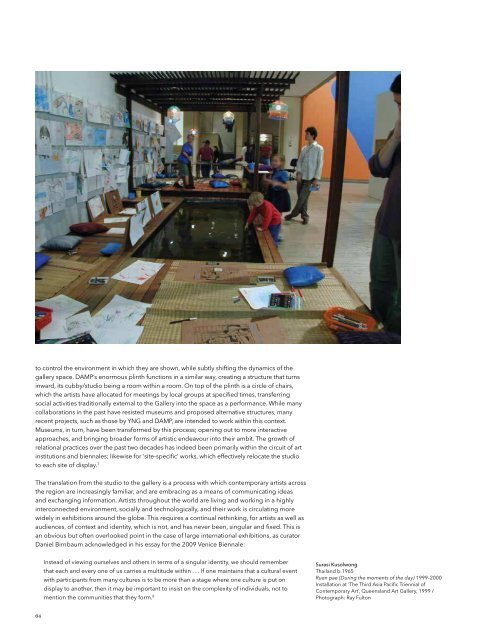Queensland Art Gallery - Queensland Government
Queensland Art Gallery - Queensland Government
Queensland Art Gallery - Queensland Government
You also want an ePaper? Increase the reach of your titles
YUMPU automatically turns print PDFs into web optimized ePapers that Google loves.
APT6 features the works of many artists born in the 1970s and 1980s, many of whom have<br />
studied overseas, and may still live there; their points of reference are fluid and multifarious.<br />
Collaboration’s complication of the singular artistic identity and ‘signature’ provides an<br />
important critical current running through APT6, which, with its focus on the contemporary art<br />
of a specific region, takes on the contestations that such a geographical framework brings.<br />
This understanding cuts across the regional bounds of the Asia Pacific Triennial, and offers up<br />
a range of possible readings of art works. These are subject to the equally diverse experiences<br />
and histories that we, as audiences, bring to them; and by opening their studio doors to the<br />
world, artists are inviting us in.<br />
to control the environment in which they are shown, while subtly shifting the dynamics of the<br />
gallery space. DAMP’s enormous plinth functions in a similar way, creating a structure that turns<br />
inward, its cubby/studio being a room within a room. On top of the plinth is a circle of chairs,<br />
which the artists have allocated for meetings by local groups at specified times, transferring<br />
social activities traditionally external to the <strong>Gallery</strong> into the space as a performance. While many<br />
collaborations in the past have resisted museums and proposed alternative structures, many<br />
recent projects, such as those by YNG and DAMP, are intended to work within this context.<br />
Museums, in turn, have been transformed by this process; opening out to more interactive<br />
approaches, and bringing broader forms of artistic endeavour into their ambit. The growth of<br />
relational practices over the past two decades has indeed been primarily within the circuit of art<br />
institutions and biennales; likewise for ‘site-specific’ works, which effectively relocate the studio<br />
to each site of display. 7<br />
Endnotes<br />
1 Chu Chu Yuan, ‘Wah Nu’s and Tun Win Aung’s art’, <strong>Art</strong>stream Myanmar, , viewed 15 October 2009.<br />
2 See Angelika Nollert, ‘<strong>Art</strong> is life, and life is art’, in Collective Creativity [exhibition catalogue], Kunsthalle<br />
Fridericianum, Kassel, and Revolver Books, Frankfurt, 2005, pp.25–9. For a historical overview of conceptualism<br />
across the world, including numerous collaborations, see Global Conceptualism: Points of Origin, 1950s–1980s<br />
[exhibition catalogue], Queens Museum of <strong>Art</strong>, New York, 1999.<br />
3 Charles Green, The Third Hand: Collaboration in <strong>Art</strong> from Conceptualism to Post-Modernism, University of NSW<br />
Press, Sydney, 2001, p.x.<br />
4 John Roberts, ‘Collaboration as a problem of art’s cultural form’, Third Text, vol.18, no.6, 2004, p.557.<br />
5 Russell Storer, interview with the artists, <strong>Queensland</strong> <strong>Art</strong> <strong>Gallery</strong>, 3 June 2009, QAG Research Library artist file.<br />
6 Pamela M Lee, ‘How to be a collective in the age of the consumer sovereign’, <strong>Art</strong>forum, vol.XLVIII, no.2, October<br />
2009, p.185.<br />
7 Claire Bishop, ‘The social turn: Collaboration and its discontents’, <strong>Art</strong>forum, vol.XLIV, no.6, February 2006, pp.178–9.<br />
8 Daniel Birnbaum, ‘We are many’, in Making Worlds [exhibition catalogue], 53rd Biennale of Venice, Marsilio,<br />
Venice, p.191.<br />
The translation from the studio to the gallery is a process with which contemporary artists across<br />
the region are increasingly familiar, and are embracing as a means of communicating ideas<br />
and exchanging information. <strong>Art</strong>ists throughout the world are living and working in a highly<br />
interconnected environment, socially and technologically, and their work is circulating more<br />
widely in exhibitions around the globe. This requires a continual rethinking, for artists as well as<br />
audiences, of context and identity, which is not, and has never been, singular and fixed. This is<br />
an obvious but often overlooked point in the case of large international exhibitions, as curator<br />
Daniel Birnbaum acknowledged in his essay for the 2009 Venice Biennale:<br />
Instead of viewing ourselves and others in terms of a singular identity, we should remember<br />
that each and every one of us carries a multitude within . . . If one maintains that a cultural event<br />
with participants from many cultures is to be more than a stage where one culture is put on<br />
display to another, then it may be important to insist on the complexity of individuals, not to<br />
mention the communities that they form. 8<br />
Surasi Kusolwong<br />
Thailand b.1965<br />
Ruen pae (During the moments of the day) 1999–2000<br />
Installation at ‘The Third Asia Pacific Triennial of<br />
Contemporary <strong>Art</strong>’, <strong>Queensland</strong> <strong>Art</strong> <strong>Gallery</strong>, 1999 /<br />
Photograph: Ray Fulton<br />
64 65
















